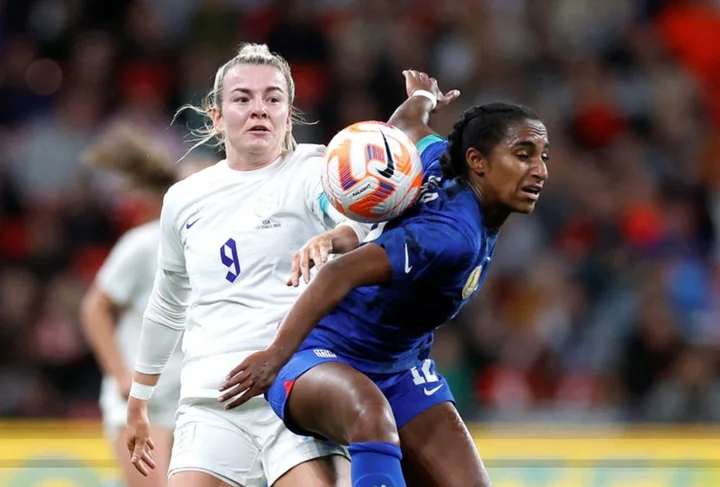By Amy Tennery
NEW YORK A new era is dawning for the U.S. women's national soccer team, as the most diverse squad the program has ever produced will pursue an unprecedented third consecutive title when the World Cup kicks off this month in Australia and New Zealand.
The squad represents a major shift from its early days and even more recent USA teams that were overwhelmingly white. Trinity Rodman will make her World Cup debut alongside veteran defender Crystal Dunn on a team that features seven Black players.
"The issue is partly about economics and partly about how hard it is to eliminate stereotypes people have about who can succeed at what sports," said Jon Solomon, editorial director of the Aspen Institute Sports & Society Program.
Retired USA goalkeeper Briana Scurry said, "for decades I was the only one of color on the roster that started."
"(Now) you have players that are really making inroads and making impacts and impressions in more ways than one who are going to be there a long time because they're very young," she told Reuters.
Scurry's penalty kick save in front of 90,185 fans at the Rose Bowl in Pasadena, California, helped the United States win the 1999 Cup, turning the team into idols for millions of American girls, in what was seen as a turning point for women's sports.
That squad offered little representation for girls of color. Scurry said she struggled to secure endorsement deals after her heroics, as the only openly gay player and as a Black woman.
"I was always going to be authentically me. I never hid that I was gay. I just was being who I am," said Scurry, a Hall of Famer and the host of the "Counterattack" podcast.
Scurry now sees the diverse soccer landscape she had wanted to be part of, and feels gratified that her pursuit likely provided some inspiration. "It's awesome because now other young girls think that they can, too."
Dunn helped the United States to its fourth overall title in 2019, but said last month she struggled growing up to feel she belonged.
"It hasn't been the easiest road, obviously," Dunn told reporters. "There are moments where I felt like I needed to conform to the environment and say, 'Okay, let me tone down who I am because I feel like there's very few of us on this team.'"
Dunn was often the only Black starter for her country in the 2019 World Cup, then celebrated as the most diverse U.S. women's squad.
"There's so many more great young players out there that are more of a better mixture of what this country is," said Scurry. "This country isn't just white."
YOUTH ACCESS
The increased diversity at the highest level of women's U.S. soccer coincides with a multi-year effort to get more minority kids onto the pitch.
"It's often difficult and takes time to widen the demographic pool of young players," said Aspen Institute's Solomon.
The institute's most recent survey found that 39% of Hispanic and 20% of white students had played soccer in high school versus only 10% of Black students.
A U.S. Soccer Foundation survey in 2008 found that even as the game experienced tremendous national growth at the youth level, large swathes of the country were being left behind.
"We developed a strategy and a business plan that focused and made a priority of increasing access and opportunity for underrepresented populations, particularly children in underserved, underrepresented communities," U.S. Soccer Foundation CEO Ed Foster-Simeon said in an interview.
The foundation has provided more than half a million children from "under-resourced" communities with free programs, building more than 600 "mini-pitches" designed for the youth game across the country.
While minority participation has improved "quite a bit," Foster-Simeon said, "it's nowhere near where we want it to be."
The problem has not been limited to soccer.
Girls at predominantly white high schools typically see 82% of the athletic opportunities boys do, according to a Women's Sports Foundation (WSF) report last year. That figure falls to 67% in schools where students of color are the majority.
Girls of color are "short-changed" in school and club programs, said WSF research head Karen Issokson-Silver.
"Sport is a microcosm of society, so a lot of the things that we see in society, whether that's systemic racism or archaic gender norms ... then you are likely to see them in sport," she said.
WSF's Sports 4 Life program, founded nine years ago in conjunction with espnW - the cable network's women's sports branch - works to increase participation for girls of color.
The chance to see a World Cup team with many diverse players will play a part for the next generation, said Issokson-Silver.
"When it comes to girls having an opportunity to see what's possible for themselves, that kind of visibility, whether it's a high school level, the collegiate level or... at the elite levels of play is monumental," she said.
That message is not lost on the women of the 2023 U.S. national team.
"Growing up, I don't really feel like that was something that I saw in professional soccer and on national teams," 23-year-old defender Naomi Girma, who will make her World Cup debut, told reporters. "I feel honored to be that representation."
At a media event last month, Dunn noted that even things like finding hair and makeup stylists who work with Black women for team events can be a challenge.
She hopes to leave the sport in a place where those that follow "don't have to fight for the same things."
"I can't hide that I'm a Black woman," said Dunn. "And so I think for me, just the more that I step into that space and I own it has really allowed and given other women of color the green light."
(Reporting by Amy Tennery in New York; Editing by Bill Berkrot)

